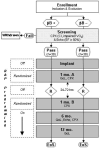The restoration of chronotropic competence in heart failure patients with normal ejection fraction (RESET) study: rationale and design
- PMID: 20123314
- PMCID: PMC2821666
- DOI: 10.1016/j.cardfail.2009.08.008
The restoration of chronotropic competence in heart failure patients with normal ejection fraction (RESET) study: rationale and design
Abstract
Background: Heart failure with preserved ejection fraction (HFpEF) is the predominant form of heart failure among the elderly and in women. However, there are few if any evidence-based therapeutic options for HFpEF. The chief complaint of HFpEF is reduced tolerance to physical exertion. Recent data revealed that 1 potential mechanism of exertional intolerance in HFpEF patients is inadequate chronotropic response. Although there is considerable evidence demonstrating the benefits of rate-adaptive pacing (RAP) provided from implantable cardiac devices in patients with an impaired chronotropic response, the effect of RAP in HFpEF is unknown.
Methods and results: The Restoration of Chronotropic CompEtence in Heart Failure PatientS with Normal Ejection FracTion (RESET) study is a prospective, multicenter, double-blind, randomized with stratification, study assessing the effect of RAP on peak oxygen consumption and quality of life. RAP therapy will be evaluated in a crossover paired fashion for each patient within each study stratum. Study strata are based on patient beta-blocker usage at time of enrollment. The study is powered to assess the impact of pacing independently in both strata.
Conclusions: The RESET study seeks to evaluate the potential benefit of RAP in patients with symptomatic mild to moderate HFpEF and chronotropic impairment. Study enrollment began in July 2008.
Conflict of interest statement
Conflicts of interest: Drs. Kass and Kitzman have received honoraria as consultants from Boston Scientific CRM. Dr. Alvarez is an employee of Boston Scientific CRM.
Figures

Similar articles
-
Effect of β-Blocker Withdrawal on Functional Capacity in Heart Failure and Preserved Ejection Fraction.J Am Coll Cardiol. 2021 Nov 23;78(21):2042-2056. doi: 10.1016/j.jacc.2021.08.073. J Am Coll Cardiol. 2021. PMID: 34794685 Clinical Trial.
-
Rate-Adaptive Atrial Pacing for Heart Failure With Preserved Ejection Fraction: The RAPID-HF Randomized Clinical Trial.JAMA. 2023 Mar 14;329(10):801-809. doi: 10.1001/jama.2023.0675. JAMA. 2023. PMID: 36871285 Free PMC article.
-
Heart rate response and functional capacity in patients with chronic heart failure with preserved ejection fraction.ESC Heart Fail. 2018 Aug;5(4):579-585. doi: 10.1002/ehf2.12281. Epub 2018 Mar 24. ESC Heart Fail. 2018. PMID: 29573575 Free PMC article.
-
Relative Impairments in Hemodynamic Exercise Reserve Parameters in Heart Failure With Preserved Ejection Fraction: A Study-Level Pooled Analysis.JACC Heart Fail. 2018 Feb;6(2):117-126. doi: 10.1016/j.jchf.2017.10.014. JACC Heart Fail. 2018. PMID: 29413366 Free PMC article. Review.
-
Impaired Exercise Tolerance in Heart Failure With Preserved Ejection Fraction: Quantification of Multiorgan System Reserve Capacity.JACC Heart Fail. 2020 Aug;8(8):605-617. doi: 10.1016/j.jchf.2020.03.008. Epub 2020 Jun 10. JACC Heart Fail. 2020. PMID: 32535122 Free PMC article. Review.
Cited by
-
Rate adaptive pacing in people with chronic heart failure increases peak heart rate but not peak exercise capacity: a systematic review.Heart Fail Rev. 2023 Jan;28(1):21-34. doi: 10.1007/s10741-022-10217-x. Epub 2022 Feb 9. Heart Fail Rev. 2023. PMID: 35138522 Free PMC article.
-
Therapy for heart failure with preserved ejection fraction: current status, unique challenges, and future directions.Heart Fail Rev. 2018 Sep;23(5):609-629. doi: 10.1007/s10741-018-9714-z. Heart Fail Rev. 2018. PMID: 29876843 Free PMC article. Review.
-
A New Model of Chronic Kidney Disease, Metabolic Derangements, and Heart Failure with Preserved Ejection Fraction in Aging Swine.Am J Nephrol. 2025;56(3):337-350. doi: 10.1159/000543327. Epub 2025 Jan 2. Am J Nephrol. 2025. PMID: 39746326
-
Novel paradigms in the therapeutic management of heart failure with preserved ejection fraction: clinical perspectives.Am J Cardiovasc Dis. 2019 Oct 15;9(5):91-108. eCollection 2019. Am J Cardiovasc Dis. 2019. PMID: 31763061 Free PMC article. Review.
-
The HFA-PEFF score and outcomes in patients with sick sinus syndrome and preserved ejection fraction after pacemaker implantation.J Arrhythm. 2025 May 12;41(3):e70088. doi: 10.1002/joa3.70088. eCollection 2025 Jun. J Arrhythm. 2025. PMID: 40357358 Free PMC article.
References
-
- Jessup M, Brozena S. Heart failure. N Engl J Med. 2003 May 15;348(20):2007–2018. - PubMed
-
- Rosamond W, Flegal K, Furie K, et al. Heart disease and stroke statistics--2008 update: a report from the American Heart Association Statistics Committee and Stroke Statistics Subcommittee. Circulation. 2008 Jan 29;117(4):e25–146. - PubMed
-
- Bursi F, Weston SA, Redfield MM, et al. Systolic and diastolic heart failure in the community. Jama. 2006 Nov 8;296(18):2209–2216. - PubMed
-
- Kitzman DW, Gardin JM, Gottdiener JS, et al. Importance of heart failure with preserved systolic function in patients > or = 65 years of age. CHS Research Group. Cardiovascular Health Study. Am J Cardiol. 2001 Feb 15;87(4):413–419. - PubMed
-
- Redfield MM, Jacobsen SJ, Burnett JC, Jr, et al. Burden of systolic and diastolic ventricular dysfunction in the community: appreciating the scope of the heart failure epidemic. Jama. 2003 Jan 8;289(2):194–202. - PubMed
Publication types
MeSH terms
Grants and funding
LinkOut - more resources
Full Text Sources
Other Literature Sources
Medical

